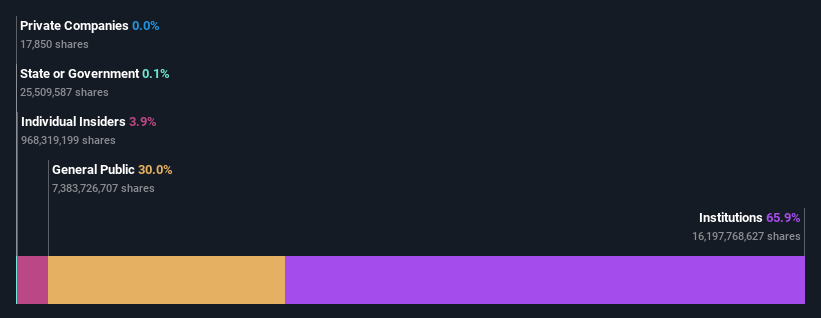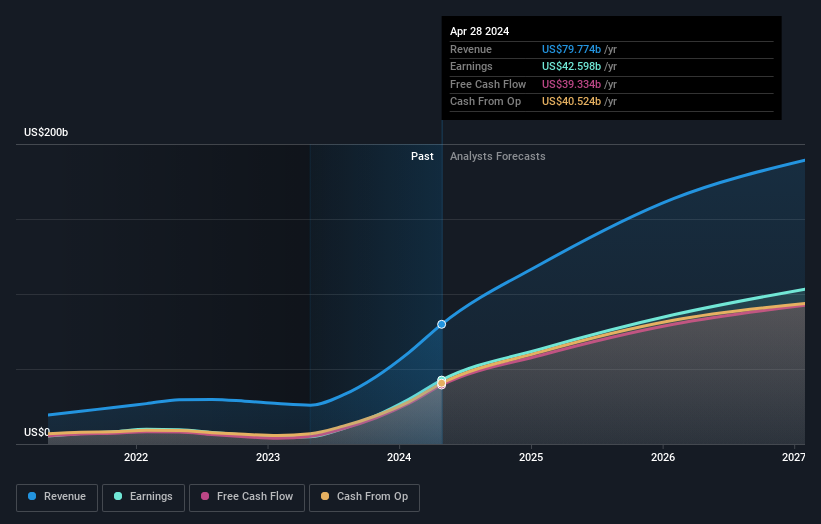CashNews.co
Key Insights
-
Significantly high institutional ownership implies NVIDIA’s stock price is sensitive to their trading actions
-
44% of the business is held by the top 25 shareholders
-
Insiders have been selling lately
Every investor in NVIDIA Corporation (NASDAQ:NVDA) should be aware of the most powerful shareholder groups. The group holding the most number of shares in the company, around 66% to be precise, is institutions. In other words, the group stands to gain the most (or lose the most) from their investment into the company.
No shareholder likes losing money on their investments, especially institutional investors who saw their holdings drop 8.5% in value last week. Still, the 142% one-year gains may have helped mitigate their overall losses. They should, however, be mindful of further losses in the future.
Let’s take a closer look to see what the different types of shareholders can tell us about NVIDIA.
View our latest analysis for NVIDIA


What Does The Institutional Ownership Tell Us About NVIDIA?
Many institutions measure their performance against an index that approximates the local market. So they usually pay more attention to companies that are included in major indices.
We can see that NVIDIA does have institutional investors; and they hold a good portion of the company’s stock. This implies the analysts working for those institutions have looked at the stock and they like it. But just like anyone else, they could be wrong. It is not uncommon to see a big share price drop if two large institutional investors try to sell out of a stock at the same time. So it is worth checking the past earnings trajectory of NVIDIA, (below). Of course, keep in mind that there are other factors to consider, too.


Since institutional investors own more than half the issued stock, the board will likely have to pay attention to their preferences. Hedge funds don’t have many shares in NVIDIA. The Vanguard Group, Inc. is currently the largest shareholder, with 8.7% of shares outstanding. BlackRock, Inc. is the second largest shareholder owning 7.4% of common stock, and FMR LLC holds about 4.4% of the company stock. Additionally, the company’s CEO Jen-Hsun Huang directly holds 3.5% of the total shares outstanding.
Our studies suggest that the top 25 shareholders collectively control less than half of the company’s shares, meaning that the company’s shares are widely disseminated and there is no dominant shareholder.
While it makes sense to study institutional ownership data for a company, it also makes sense to study analyst sentiments to know which way the wind is blowing. There are plenty of analysts covering the stock, so it might be worth seeing what they are forecasting, too.
Insider Ownership Of NVIDIA
The definition of company insiders can be subjective and does vary between jurisdictions. Our data reflects individual insiders, capturing board members at the very least. The company management answer to the board and the latter should represent the interests of shareholders. Notably, sometimes top-level managers are on the board themselves.
I generally consider insider ownership to be a good thing. However, on some occasions it makes it more difficult for other shareholders to hold the board accountable for decisions.
We can see that insiders own shares in NVIDIA Corporation. The insiders have a meaningful stake worth US$109b. It is good to see this level of investment. You can check here to see if those insiders have been buying recently.
General Public Ownership
The general public, who are usually individual investors, hold a 30% stake in NVIDIA. While this size of ownership may not be enough to sway a policy decision in their favour, they can still make a collective impact on company policies.
Next Steps:
I find it very interesting to look at who exactly owns a company. But to truly gain insight, we need to consider other information, too. Be aware that NVIDIA is showing 1 warning sign in our investment analysis , you should know about…
But ultimately it is the future, not the past, that will determine how well the owners of this business will do. Therefore we think it advisable to take a look at this free report showing whether analysts are predicting a brighter future.
NB: Figures in this article are calculated using data from the last twelve months, which refer to the 12-month period ending on the last date of the month the financial statement is dated. This may not be consistent with full year annual report figures.
Have feedback on this article? Concerned about the content? Get in touch with us directly. Alternatively, email editorial-team (at) simplywallst.com.
This article by Simply Wall St is general in nature. We provide commentary based on historical data and analyst forecasts only using an unbiased methodology and our articles are not intended to be financial advice. It does not constitute a recommendation to buy or sell any stock, and does not take account of your objectives, or your financial situation. We aim to bring you long-term focused analysis driven by fundamental data. Note that our analysis may not factor in the latest price-sensitive company announcements or qualitative material. Simply Wall St has no position in any stocks mentioned.
Have feedback on this article? Concerned about the content? Get in touch with us directly. Alternatively, email [email protected]
#cashnews #UnitedStates #newsfinace #finance #FollowsCashnews
